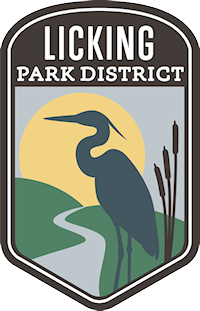Dreaming of Wildflowers, Licking Park District Partners with US Fish and Wildlife Service
Dreaming of Wildflowers, Licking Park District Partners with US Fish and Wildlife Service on a 32-acre Prairie Habitat Improvement Project at Infirmary Mound Park
GRANVILLE, OHIO (April 24, 2020) Visitors to Infirmary Mound Park (IMP) may wonder why the fields east of Rt. 37 have been cleared. These areas will be the location of a prairie habitat improvement project resulting from a partnership between the Licking Park District (LPD) and the U.S. Fish and Wildlife Service, Partners for Fish and Wildlife Program (USFWS-PFW). The roughly 32 acres of new grassland will provide critical habitat for pollinators, migratory grassland nesting birds, and other local wildlife species. Additionally it will provide accessible learning opportunities for park programming and a beautiful landscape to relax in for the many visitors who use the trails.
The key to establishing successful prairies is to remove all existing vegetation before planting. Visitors should expect to see bare fields through 2020. The project will occur in two phases. Phase 1 involves 15 acres east and south of Paws 2 Play dog park. Vegetation was removed from the area through the responsible application of herbicide in September of 2019. A second herbicide application will occur in spring 2020. Using a no-till seed drill, the area will be planted with the seeds of 34 Ohio native wildflower species and seven Ohio native warm season grasses. New growth will be apparent through the 2020 growing season. Phase 2 involves 17 acres along Rt. 37 that lie north of the IMP office and west of Mirror Lake. Woody vegetation was mechanically removed in February 2020. The area will be kept bare throughout the summer by brush hogging and then in late summer will be tilled. The ground will be frost seeded in the winter of 2020 with the same mix of wildflower and native warm season grasses. Utilizing two different methods of planting, drill and frost seeding, will provide a useful learning tool for comparing results.
Early successional habitats in Ohio include prairies, pastures, meadows, and shrubby old fields. They are one of the habitats that show the greatest amount of habitat loss in Ohio. The project target areas at IMP are old farm fields that had matured to shrubland. While many may perceive this habitat as messy or unkempt, this type of habitat is in decline yet extremely valuable for a wide range of species. The IMP fields have been inundated with a variety of invasive species and that, along with other considerations, made prairie restoration the appropriate management choice. The LPD will be maintaining 25 acres of early successional shrub habitat in the fields on the Canyon Rd. side of IMP.
Prairie plantings take 2–3 years to mature. Each year the native grass and wildflower composition will change as plants mature and naturally re-seed. Initially prairie plant growth will be underground. Small plants can easily be shaded out if weed growth is not controlled. Weed management will be done by brush hogging and/or controlled burns. Prairie plants are resistant to burning and will not be killed. In future years burning or mowing will be done every 2–3 years. Once mature, prairies require less intensive management and are less expensive to maintain.
This project gives LPD an opportunity to monitor the changes in wildlife that occur. Citizen scientist volunteers began butterfly monitoring in 2019. This monitoring will continue annually, allowing us to determine if habitat changes have helped attract new species. Future monitoring projects will include bird, dragonfly, and iNaturalist inventories.
